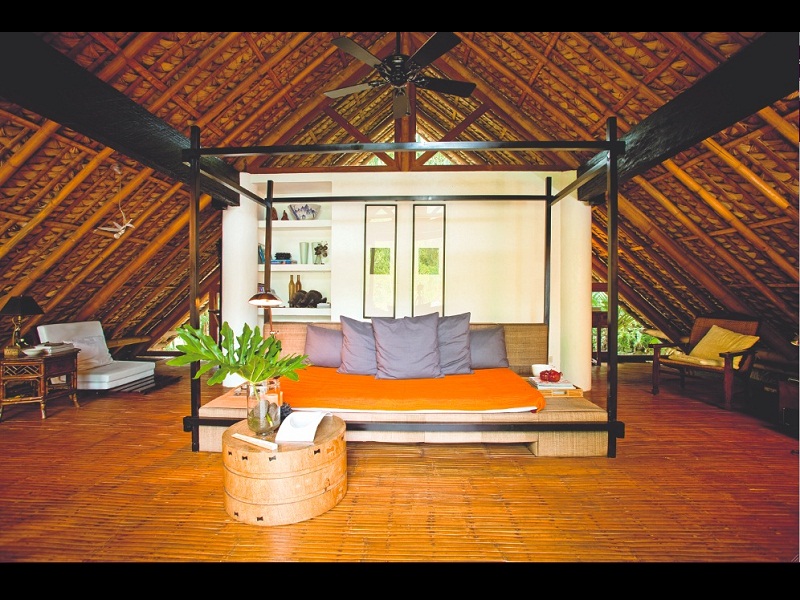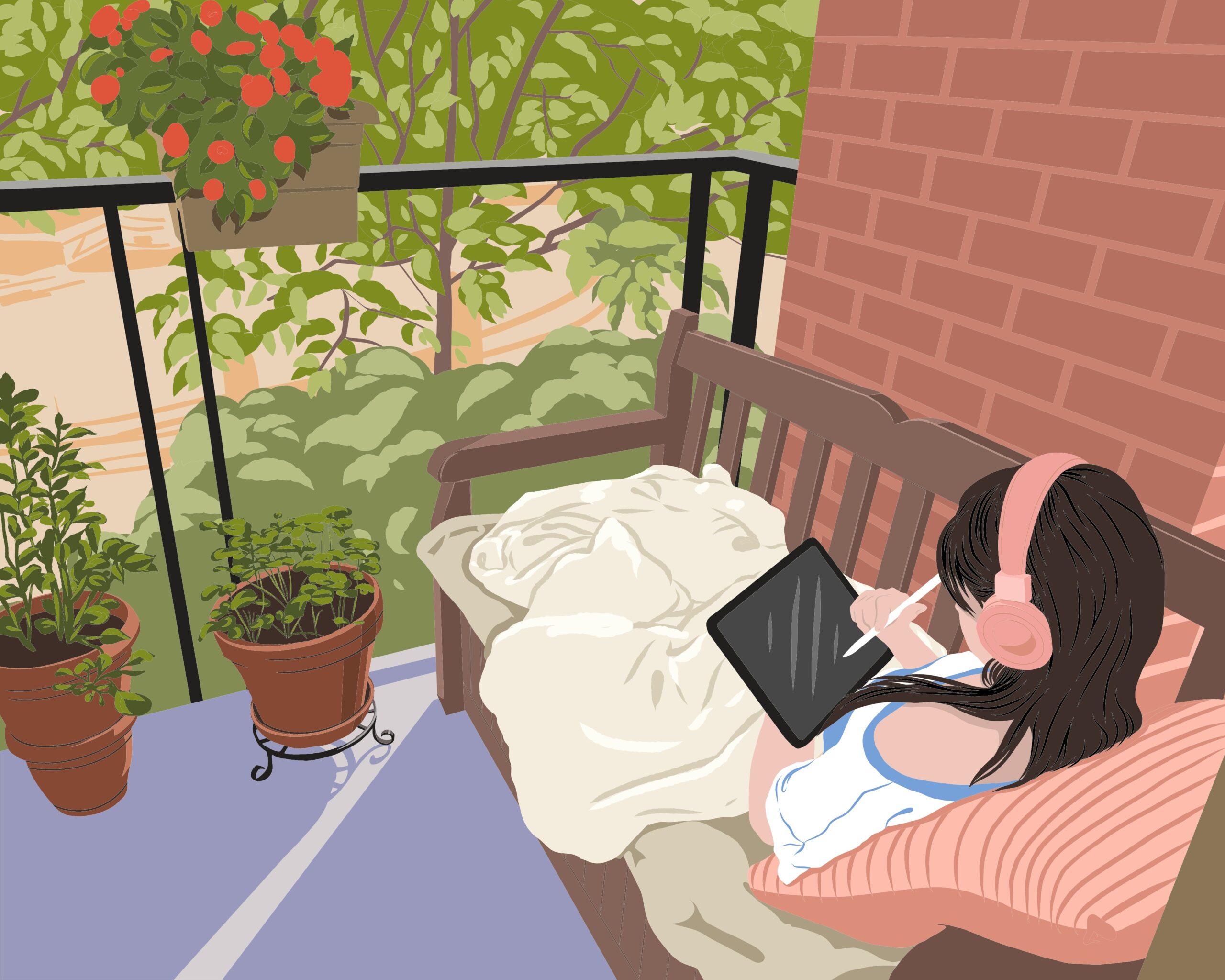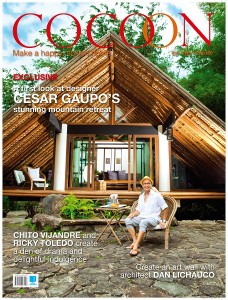
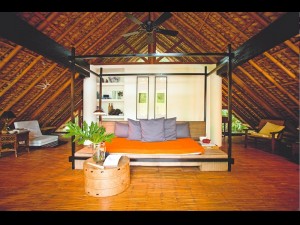
The ride to Majayjay, Laguna, is a short three hours, and yet finding Cesar Gaupo’s weekend retreat here on the foothills of Mt. Banahaw is like looking for a needle in a haystack. After many wrong turns, you finally reach the dirt road that leads you to his resthouse.
“I had friends who got lost on the way here,” says Gaupo. “They got here at 5 p.m. And they were supposed to be here at lunch.”
It’s not surprising why his friends and guests lose their way. The vista of coconut trees and the mystical Mt. Banahaw is endless. You need a good eye and perhaps a GPS to find your way around.
But you forget all that arduous search once you reach his place. The last thing you expect to see in the heart of the jungle is a massive wall of concrete that seems to have sprouted as if magically. Think of the wardrobe that led Lucy into Narnia. The experience is quite as amazing.
You push open antique wooden doors and find yourself facing a Balinese-style house but with cogon thatch roof akin to that of an ulog. The house is raised from the ground to give it the appearance of an open structure. This sense of airiness, if not lightness, pervades the house itself. An open layout provides a clear space where friends can chat and even lie back on a lazy afternoon. Divans are arranged to encourage chatter.
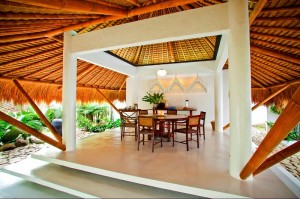
If guests lack for topics, a variety of objects around could inspire casual banter: a Buddha head, a nipa seedpod, books, and magazines.
This house has no walls; only glass corners delineate space. There is no barrier between indoors and outdoors—except for doors at opposite ends of the house.
Stepping out of this house, you find yourself in a grassy courtyard. There are two houses on either side. On your left is the guesthouse in an all-glass structure fitted out in Filipino modern. On your right is more open space similarly raised above the ground. Six Raj-style chairs surround a round antique table. A buffet table and tea trolley at the rear have all the provisions you need should you crave for coffee or snacks in the middle of the day. This is the official dining area.
At the end of the courtyard is a concrete wall with antique wooden doors.
And then you hear it, the sound of rushing water. Stone steps on the other side of the door lead you down to a river, which Cesar says is always busy whatever time of the year. This river separates the property’s “public” areas from the master’s bedroom, which lies past an embankment. Another wall hides a full view of the house, which is the master’s bedroom.
Then you begin to marvel at the mind that conceived this imaginative layout.
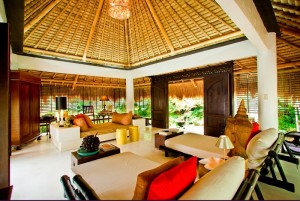
Cesar Gaupo is one of the country’s esteemed fashion designers. After carving a name for himself in the country, he was tapped by Shanghai Tang to design the global brand’s collections. The peripatetic life overseas eventually got to him and he decided to come home a few years ago.
As early as then, he wanted to create his weekend retreat, something that was off the beaten track. A visit to the home of close friend Larry Espinosa in Majayjay, Laguna, brought his attention to the potential of the area. After two months of regular visits to this faraway town in Laguna, he found a 1,700 square meter riverside property that suited his vision of a getaway. That was four years ago.
If you ask him how he designed the place, Gaupo would only smile and with a chuckle admit that he had no idea. He did several drawings of how he wanted things to look like and just immersed himself in the job. That was pretty much how he did it.
“As a child, I loved to draw,” he confesses. “One of the things I would draw was houses. All those years, I had an idea of what I wanted for a home. That idea guided me when it came to constructing this weekend retreat.”
When he discovered this lot, it was overrun with coconut trees. Cutting down the trees was the first order of the day. After that, he started work on his bahay kubo. Everything else followed.
The stone steps leading to the master’s bedroom were made by Igorot workers who were then at work in a nearby resort in Laguna. When they were done with their resort job, they moved over to his place to work on the riprapping of the banks between the two parts of the property. All that was done with the use winches and a lot of muscle. Then, the water from the river that flows through the property was regulated by damming up its mouth.
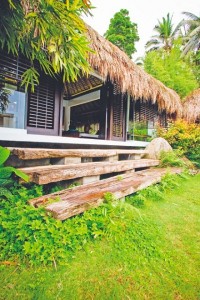
Today, whatever time of year, be it summer or the rainy season, a steady stream of water flows past. The river’s upper side has also been dammed for a pool where guests can swim. The water is fresh and cool, as it comes down from Mt. Banahaw.
As construction work was under way, he was busy replanting the estate. To serve as cover, the riverbanks were planted to calateya. Throughout the property, he planted trees mostly for cover: pole bamboo, Thai bamboo, and white bamboo. Everything else sprouted naturally the past four years. There are now all kinds of ferns and even cycads. While there is a sense of order to the growth, nature also took its course. Somehow, this lush wilderness blended well with the arranged landscape.
“If you asked me the specific names of the plants growing here, I won’t be able to give you all their names,” Cesar admits. “I know the names of the plants I brought here. Everything else just grew from the ground.”
The pavilion that is now the master’s bedroom was the first to be built on the property. It is a free space with the furniture indicating the function of a given space. A stylized four-poster bed is the focal point of the room. Behind it is shelving that serves as divider between the toilet and bath behind. In front of the bed is the gear of an old-fashioned press that now doubles as coffee table. To the sides are low seats that level with the floor. An entertainment console is one of the room’s modern-day conveniences.
To insulate the house from the outside, glass walls have been installed. Any day of the year, you wake up and see the outdoors. On a moonlit night, you can sleep with the beautiful view of the outdoors.
Cesar says he intends to have the roofing of this house changed from the old anahaw thatching to cogon. The fan-shaped pattern the anahaw leaves create on the ceiling will be missed. In parts, it is already beginning to grow old and rotten. The cogon thatching used in the rest of the houses or pavilions in the property is more durable and gives the houses a more indigenous feel.

The pavilion that is the guest room is still spare because it has just been completed. Cesar has yet to dictate its style. But the glass walls already bring a feeling of the outdoors. Lush plants grow around the house as if in a jungle. There are screens that can be lowered for privacy in the evening. A toilet and bath at the back complete the amenities.
The dining area pavilion is really the life of the place, where Cesar entertains guests most of the time. It is, in fact, an open space, with only a wall hiding the kitchen and guest toilet and bath.
The kitchen has been painted an immaculate white; you have a mind to brush your shoes on the mat to keep the floors pristine. A white cotton tablecloth usually covers the table. When we removed it for our shoot, it revealed a solid wooden table. To give detail to the bare walls, where lighting is installed, a cutwork of palace roofs covers the bulbs.
The property is meant to be a prototype for more properties Cesar is planning to develop around the area. A number of local residents and visitors from Manila have come up to his home to have a look. Some have offered to buy the property, others have asked him to design their own space. He is taking his time for he doesn’t see this property as finished yet.
“I want to have the stone steps changed one of these days,” he says as he surveys the property. “Somehow, it doesn’t seem right yet.”
Cesar is in Majayjay four days a week. After he completes his work in Metro Manila, he hies off to Laguna for a break.
“It really was the joy of doing it every day,” he says. “You just don’t know when the whole thing would be done.”
COCOON MAGAZINE is available in all leading newsstands and bookstores nationwide.

